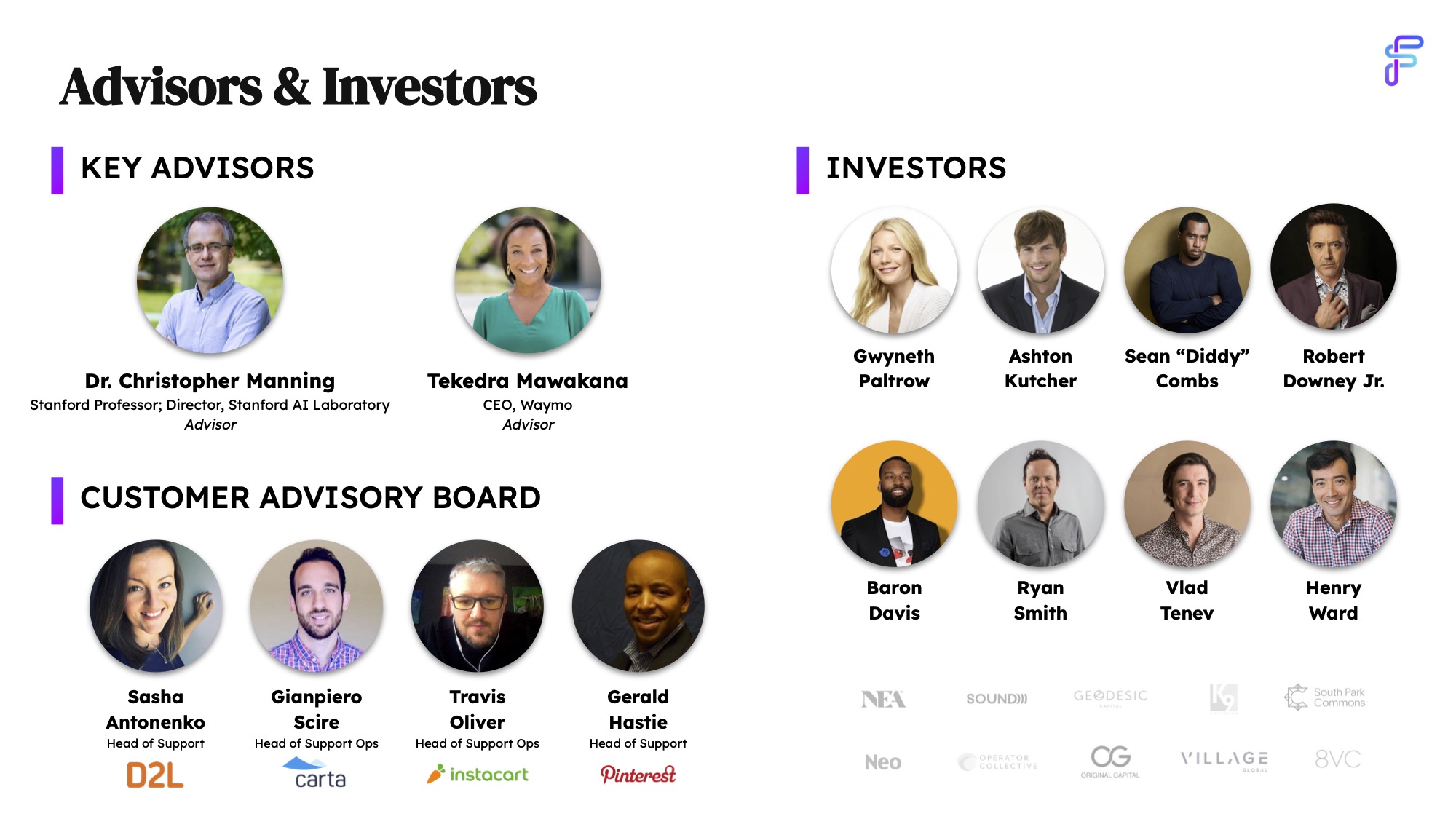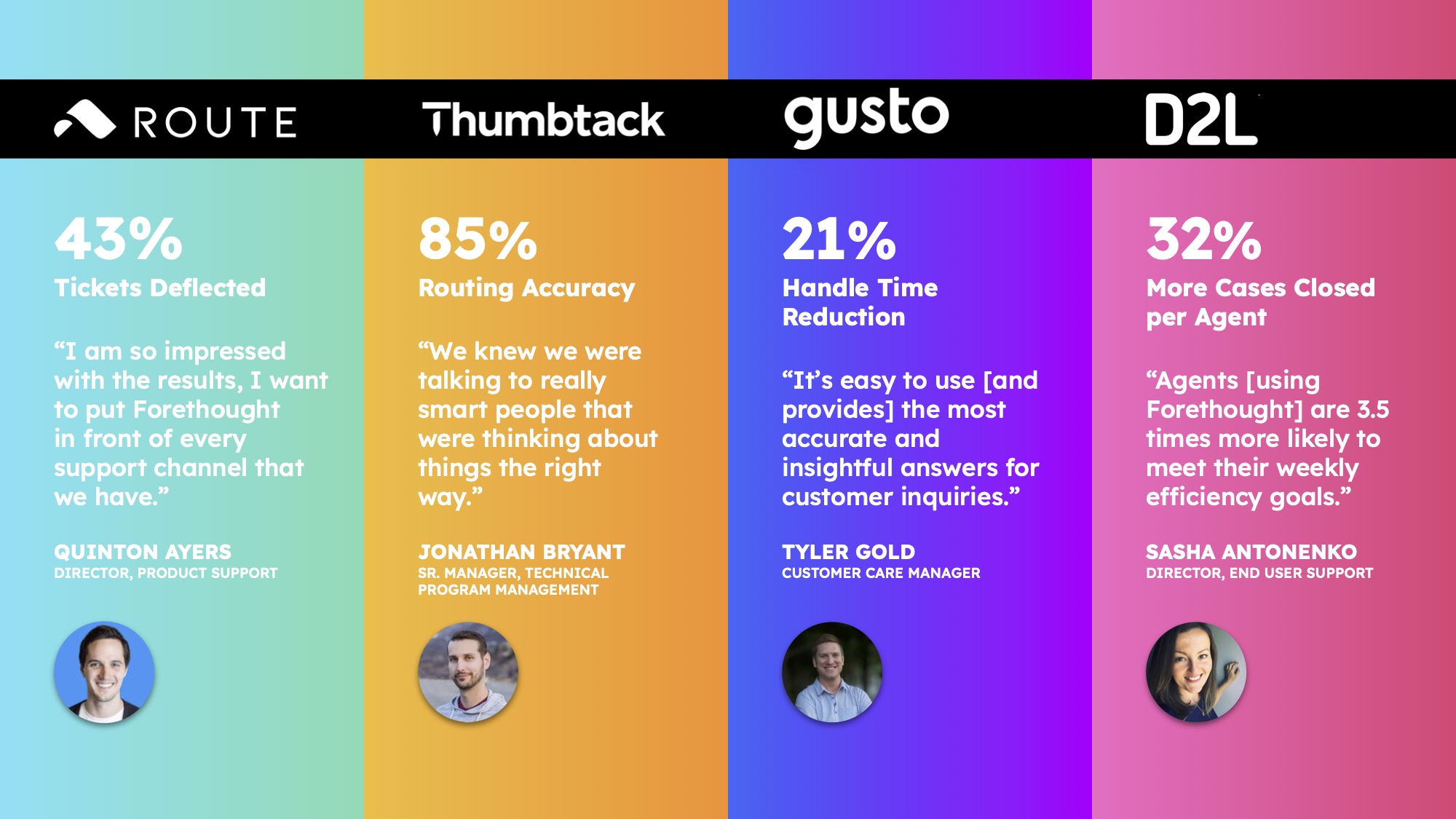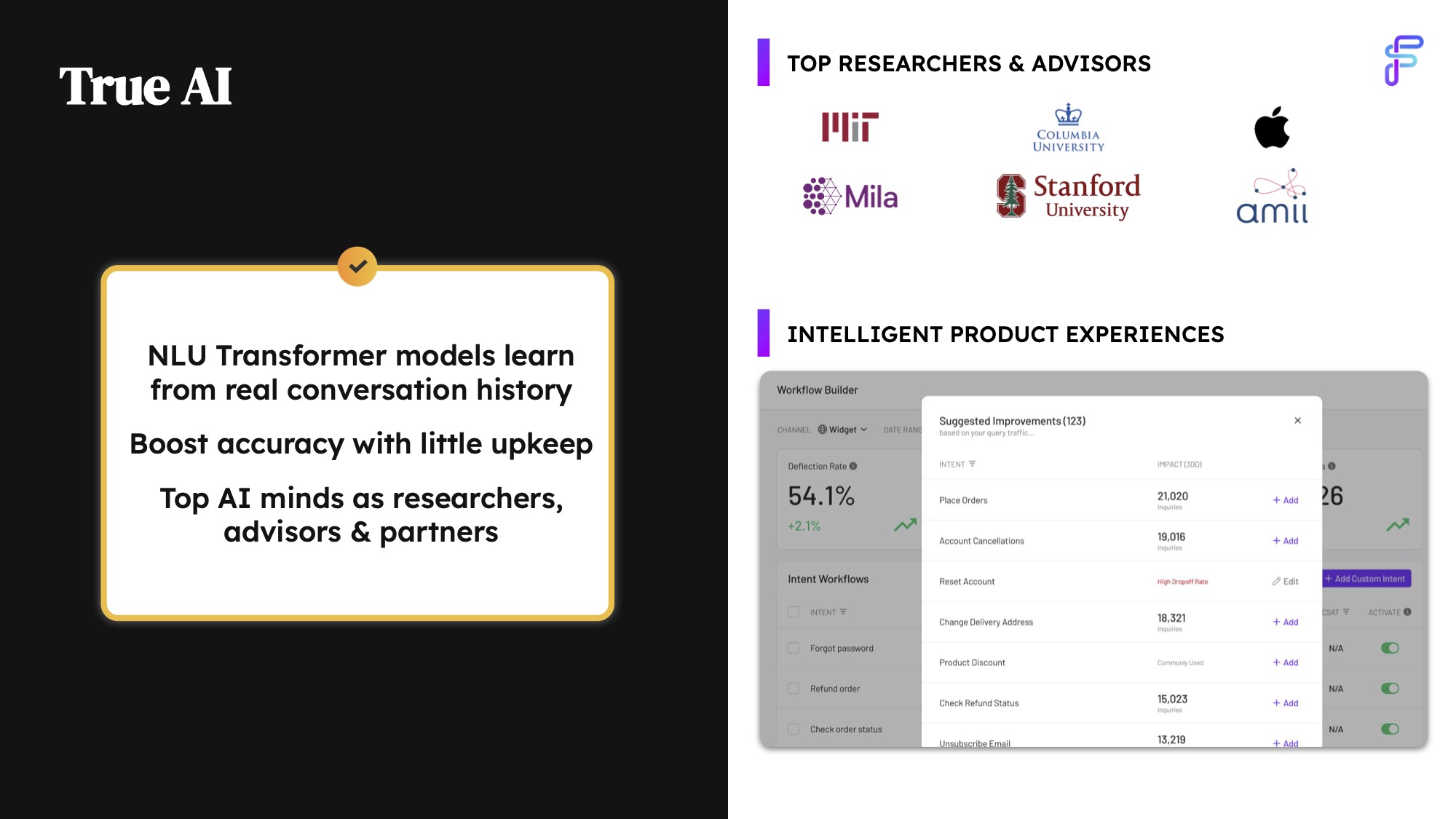Forethought has been on our radar for a long time — the company won our 2018 Startup Battlefield at TechCrunch Disrupt, and just a few weeks ago, CEO Deon Nicholas joined Vanessa Larco from NEA on TechCrunch Live to talk about pitching and pitch decks:
Today, it’s my pleasure to tear down the company’s 23-slide deck that helped it raise a $65 million Series C late last year.
Forethought’s mission is to help humans perform better using AI. “One of the things that we’ve focused on is being a human-centered AI platform. And that’s what has really come through … with our mission, and really our mission is to unlock human potential through artificial intelligence,” Nicholas told TechCrunch’s Ron Miller.
We’re looking for more unique pitch decks to tear down, so if you want to submit your own, here’s how you can do that.
Slides in this deck
In the vast majority of cases, this is a slide that makes my eyes glaze over; Forethought’s slide made me do a double take because it is a rare exception to that rule.
- Cover slide
- Founders slide
- TechCrunch Disrupt Startup Battlefield slide — (Yes, really!)
- Traction slide (redacted numbers)
- Customer list slide
- “Forbes 2021 next billion-dollar startups” — mystery slide
- “Think about the last time you were on hold” — problem slide
- “The cost of bad customer service” — problem slide
- “Transform customer experiences with human-centered AI” — solution slide
- “Complete platform” — product slide
- “True AI” — product slide
- “Rapid time-to-value” — product slide
- “Secure and trusted” — product slide
- “Intelligent gap detection” — product slide
- “Trusted by the best” — customer breakdown slide
- “Metrics Summary” (redacted) — traction slide
- Customer testimonials slide
- ARR expansion per cohort (redacted) — customer development slide
- “Forethinkers” team slide
- Advisors and investors slide
- “What’s next” (redacted) — road map slide
- “Where we’re going” (redacted) — revenue growth slide
- “Unlock human potential through AI” — mission slide
Three things to love
There’s a lot to love about this deck, and it’s hard to only pick three things. In the past few pitch deck teardowns, I’ve often focused on the beginning of the narrative — the first few slides.
Ending on mission

[Slide 23] Closing slide. Image Credits: Forethought
A lot of the time, the final slide is just a repeat of the company’s tagline or motto and the founder’s contact details; it’s logical to repeat your vision or mission here, but it’s rarely done, and that’s a shame. If you have a clearly articulated mission, why not fly that flag as you’re doing your pitching?
Ugh, an investor slide

[Slide 20] Advisors, investors and customer advisory board. Image Credits: Forethought
Having the CEO of Waymo and a Stanford AI lab professor as advisors is a flex. The customer advisory board includes (presumably busy) decision-making customers for Pinterest, Instacart and Carta. And the investors? Well … it’s not always clear how much actual time individual investors put into a startup, and that’d be a question I’d be asking Forethought, but it’s certainly a conversation starter: How did the company pull off adding a handful of household names to its cap table, and will they add value beyond their cash and famous faces?
Contextualized numbers are sexy

[Slide 17] Customer testimonials. Image Credits: Forethought (opens in a new window)
In my past startups, I’ve done a lot of customer support, and if anyone had put any of those stats in front of me, I’d have bought on the spot: 43% of customer interactions don’t result in a support ticket? Routing accuracy of 85%? Handle tickets 21% faster and get 32% more productivity out of each of your customer support staff? That’s extraordinary by any measure — but tying it to customer testimonials makes the story come to life so much more. Very well done indeed. It also helps that the slide is well designed, easy to read and the logos show that these are a solid lineup of customers, too.
In the rest of this teardown, we’ll take a look at three things Forethought could have improved or done differently, along with its full pitch deck!
Three things that could be improved
Forethought raised $65 million with this deck, but that doesn’t mean it couldn’t be even better! Here are a few of the things I noticed.
More clarity please!

[Slide 6] What is this? Image Credits: Forethought (opens in a new window)
If you need to rabbit-hole on tech, that’s fine, but that’s your appendix is for.
I googled it, and it turns out that, yes, Forethought is on the 2021 Forbes next billion-dollar-startups list, but if I have to google something that’s on a slide to figure out what it’s meant to do, it’s a failure.
Of course, the founders would be using this slide to talk about their successes and recognitions, but without the benefit of a voice-over, this isn’t clear enough.
I invite you to think about the slide in three contexts: How does it read if an investor flicks through the deck before the meeting? How does it work as a presentation deck for you to talk over? How does it work as a “leave-behind deck” — i.e., the one that you send to the investors after a meeting is complete? Sometimes, I recommend making three versions of a deck: One is a send-ahead deck that investors can use to choose to take a meeting or not. On this version, you could use a bit more text if you need to contextualize slides or explain things. The second version is your presentation deck. Less text, but you know you’ll be there to give voice-over and context, and you can tie the slides together nicely. Finally, a take-home deck. This is probably the same as your send-ahead deck, but you should also include relevant appendices (and yes, your deck should probably have appendices).
In any case, if this deck is Forethought’s presentation deck, this piece of feedback is moot — but remember this for your own pitch decks: If they are meant to be consumed without your voice-over, they have to make sense in isolation.
A bit heavy on product

[Slide 11] A product slide. Image Credits: Forethought (opens in a new window)
I fully understand the company’s desire to show off the parts of the product it is proud of, how it works, etc., but I’m willing to bet that “top researchers & advisors” was glossed over in every single meeting. Why? Because nobody cares: It’s too in the weeds. If the customers are happy (and it seems that they are) and the revenue chart is going up and to the right, you’re probably better off using benefits-based messaging than going deep on the tech. The cool thing is that Forethought already showed that it has mastered the benefits-based narrative, as I hinted at in the section about Slide 17. Showing how this helps your customer is going to be a lot more helpful than this set of product slides — and you can probably trim down from seven to one or two slides in the process.
Keep it simple and clean in the main deck. If you need to rabbit-hole on tech, that’s fine, but that’s what later conversations and your appendix are for.
Careful what you highlight!

[Slide 19] Team talk. Image Credits: Forethought (opens in a new window)
Again, I suspect that this is a presentation deck and that the founders have a coherent narrative that goes with both the founder slide (“Why are these the perfect people to run this company?”) and with the broader team slide. For the latter, I expect Forethought can point to its diversity figures and speak to why each business unit of the company is in good hands with these folks. It’s also likely that they’ll make a big deal out of these people being great hiring managers and that is the thing that unlocks the hiring of an additional 100 people following the Series C.
But none of that comes to the forefront on this slide, and it’s hard to say whether this adds any value at all to this deck. With a voice-over, maybe, but as-is, I’d argue to move Slide 19 to the appendix. Other approaches could be to highlight the most important business units and why they are in good hands — or just get rid of it altogether.
Where’s my operating plan?
I might also have criticized Forethought for its lack of an operating plan or detailed financials, but the founders left me with a note, stating that the total annual recurring revenue and year-on-year growth numbers were removed, alongside details on the product road map and a financial summary. I understand why the company may not want to share this sensitive data with the rest of the world — but if you use this deck as an example, remember to include all of that!
The full pitch deck
If you want your own pitch deck teardown featured on TC+, here’s more information. Also, check out all our Pitch Deck Teardowns and other pitching advice.
